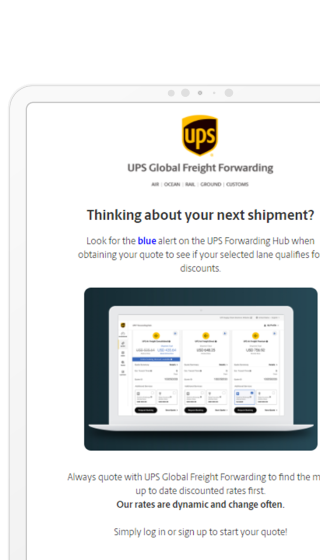5 Simple Ways to Help Avoid International Shipping Delays
If the past few years have taught us anything, it’s that the only thing that’s really predictable is unpredictability.
Global pandemics and international conflicts have manifested themselves into factory shutdowns, cancelled flights, bottlenecked ports, staffing shortages, rerouted shipments, longer transit times as well as soaring surcharges and fuel prices. “Supply chain issues” has become the catch-phrase for almost everything.
But even in complicated times, savvy shippers can find ways to navigate turbulent waters and stay ahead of their competition. Simple attention to detail, adherence to rules and avoiding self-inflicted wounds can help keep shipments moving smoothly, even when the supply chain process isn’t.
Recently, a panel of UPS® Global Freight Forwarding executives met to discuss common-sense tips to help international shippers mitigate the risk of painful shipment delays in their supply chains.
1. Don’t go it alone
When supply chain capacity is disrupted, what once worked smoothly may no longer work at all. It’s important to have options. Any good strategy starts with a solid plan, a better back-up plan, and a freight forwarding service provider you can trust.
“A good freight forwarder can get you access to options you may not have thought of,” said Keith Andrey, VP of UPS Global Freight Forwarding. “Different modes, different ports, even a different steamship line if you deal directly with the carrier. With the right understanding of demand and need, your forwarder can help you make decisions on carrier routing selection, from different, less-congested ports, to better inland port intermodal rail transits, to mode shifts to address urgent orders.”
However, good planning sometimes happens well in advance of a disruption. Adjusting on-the-fly is key. “Shippers shouldn’t be afraid to re-prioritize products with the available capabilities of all the parties within the supply chain,” Andrey said.
Good collaboration with your forwarder, along with seamless communication between buyer, factory, carrier, and the receiving distribution center, can help reduce days-in-transit in the port-to-port journey, as well as the final mile to your customer’s door.
2. Today’s forecast calls for better forecasting
Accurate, early forecasting is critical in turbulent times. “As a general rule,” said Jill O’Dell, Vice President UPS Global Freight Forwarding Global Strategy and IE, “forwarders purchase space well in advance of shipments actually moving. So when shippers can tell their forwarders, ‘Hey I have a new product line coming in six months,’ it can help ensure space is available when that time comes.” To better navigate volatile conditions, insightful advance forecasting helps the forwarder plan labor, space and everything else to keep your plan on track.
Other considerations include shipping ahead of deadlines, getting ahead of inventory planning, focusing on the right product mix and not ordering more than your consignee can handle. “Today, more than ever,” O’Dell said, “Last-minute forecasting is a recipe for disappointment.”
3. Don’t be afraid to optimize routes and modes
Any given day, something unpredictable can upset the status quo. Labor shortages, port shutdowns, chaos in the Suez Canal. Your ability to quickly reoptimize routes can minimize or mitigate delays. Can you route shipments differently to circumvent congested lanes? Can you source from somewhere different? Can you adjust shipment size to take advantage of alternate modes? Or use different modes than you’re used to?
“One of the big shifts we’re seeing is that customers are switching from a lowest-cost-per-unit view of transportation to a most-efficient-end-to-end-transit view,” Andrey said. “Understanding your end-to-end options by mode—even by port—can help determine the most optimum flow.”
Also, by adjusting order sizes to optimize for air, ocean or rail transport, you can often save days in transit. “That’s not something buyers and planners on the customer side are used to doing,” Andrey pointed out. “But when it’s less about unit cost, and more about optimizing order size and the configuration of cartons and skids for different modes, you improve your odds that goods flow through the supply chain as fast as possible.”
4. Details matter in Customs clearance
One of the biggest causes of shipment delays is a Customs inspection. Even worse is a loss of importation privileges. So, while speed matters everywhere else in the supply chain, when it comes to Customs forms and compliance, shortcuts are a recipe for disaster. Bruce Kidwell, VP Global Customs Brokerage and Trade Advisory Services at UPS Global Freight Forwarding, said, “If you start trying to shortcut compliance, change documentation, or change classifications to reduce duty, you’re putting your shipment at risk.”
Once you've gotten Customs’ attention, you risk losing your license to import, or you may see every shipment flagged for inspection. Customs requires a lot of information. But methodical attention-to-detail and accuracy is the best way to avoid delays. Here are some simple pitfalls you can easily avoid; make sure:
- Your forwarder and broker have your contact information, email and phone number
- You select a broker and have an account with a Power of Attorney established
- You have the right documents for Customs and other Partner Government Agencies (PGA). Every country has PGAs beyond Customs that can impact clearance. (In the U.S. there are more than 20 agencies, including Fish & Wildlife, FDA, etc.)
- You don’t wait until your shipment is at the port or air freight facility to think about these things
5. Focus on compliance first
“It seems simple,” said Jill. “Provide your forwarder or broker with an accurate description of your goods.” Without it, the shipment is forced to stop, and the customer must be contacted to appropriately classify the goods. That’s a big deal. More countries are asking transportation companies to provide classification—upfront—prior to departure, such as the new Import Control System 2 (ICS2) in the EU.
Jill offers a simple rule-of-thumb for classifying goods for smoother sailing through brokerage: “I call it the ‘Four Words Rule,” she says. “If you can use four words to describe your item, it’s going to help the broker to better classify your goods. Instead saying ‘t-shirt,’ say ‘cotton-knitted women’s t-shirt.’”
Provide your broker with your parts table in advance, a simple list of your parts, their descriptions and tariff codes. These can be automatically loaded in their system to better automate the process and reduce holds.
“Finally,” Jill added. “We encourage customers to send us sample documents for their most common shippers, before we start shipping goods. Then we can say, ‘Hey, this vendor’s invoices aren’t as clean as they should be, or do a comparison. This is especially important in other countries.”
As much as you plan ahead and leverage forecasts to ensure available space, the reality is, if your shipment is stuck on a ship outside the Port of Los Angeles, there’s only so much your broker can do to push it through. Delays happen. Allow more time than you have historically, prioritize the inventory you really need and make sure your forwarder understands the priority of items. Then ship early and ship accurately. With the five tips presented above, you can hopefully bring a bit more order within the chaos of the supply chain market.






